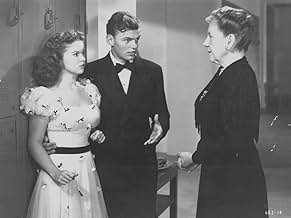Mary Hagen lives in a small town in Ohio and goes to Jordon Junior College. For years, there have been whispers, rumors and gossip about who her real parents are. After Tom Bates returns to ... Read allMary Hagen lives in a small town in Ohio and goes to Jordon Junior College. For years, there have been whispers, rumors and gossip about who her real parents are. After Tom Bates returns to town, he takes over the house and practice that Judge Merrivale left him following his dea... Read allMary Hagen lives in a small town in Ohio and goes to Jordon Junior College. For years, there have been whispers, rumors and gossip about who her real parents are. After Tom Bates returns to town, he takes over the house and practice that Judge Merrivale left him following his death. As Tom has been away a number of years, this leads to more gossip and Mary believes th... Read all
- Director
- Writers
- Stars
- Awards
- 1 win total
- Director
- Writers
- All cast & crew
- Production, box office & more at IMDbPro
Featured reviews
I watched this mainly to see Shirley Temple as an adult rather than a tyke and Lois Maxwell play something other than Miss Moneypenny. Temple is surprisingly pretty and her acting is at least as good as everyone else's in the picture. I found the romantic turnarounds a bit confusing, though -- young Ken turns into a spineless mama's boy, Miss Lane and Tom Bates decide they are just "good friends", and Bates (who for most of the movie is suspected to be Mary's father) is now in love with her! That was a little creepy and not terribly convincing. It's not a movie I would recommend exactly, but it was certainly watchable and of archival interest, if nothing else.
It's uncomfortable and odd viewing. In the film, Tom Bates, the male lead, is suspected by the entire village - and Janie herself - of being her true father (though he's not). He meets her as a young woman, when she is aged about seventeen and he is approximately twice that. He tries to help her, encouraged by a local teacher. The townfolk get meaner and meaner, because they view Janie as being "of bad stock" because she's believed to be illegitimate and adopted. Then suddenly right at the end Tom has proposed and they're getting married. There's no build up, there is no relationship progression. It's not apparent that he has ever had romantic feelings for her, let alone her for him. So it's rushed and jarring and odd.
Ronald Reagan apparently viewed the age gap as problematic, and wanted to change the ending. This left me wondering whether - rather like Girls' Dormitory (1936) - they changed the ending of the original story. In the play Girls' Dormitory is based on, the headmaster ends up marrying a teacher colleague of a similar age who has loved him for years. In the film, Herbert Marshall ends up proposing to Simone Simon, his teenage student, leaving his poor colleague with a broken heart.
I was so curious that I managed to source a copy (they are rare and it was expensive). As it turns out, for the most part - and particularly the start - the movie is quite faithful to the book. Both conjure up a similarly convincing atmosphere of poisonous small minds in a small town. The ending is also the same, in that Tom Bates does end up with Janie, not with the teacher of similar age who loves him.
However the book shows Tom Bates' romantic interest in Janie clearly developing from early on, and to a lesser extent, hers in him. This isn't entirely satisfactory on his side because she is in love with and engaged to someone else, Tom leaves, then Janie is jilted, and eventually she starts seeing someone else whom she doesn't really care for. Then at the eleventh hour, Tom returns and suddenly they're both going off into the sunset. The book feels rushed as well, though not nearly so much as the film does.
Ultimately, the conundrum remains unresolved. My speculation is that scenes between Temple and Reagan were cut - either from the script, or in editing - because they just weren't deemed palatable. Temple had been a child star, after all. It's one thing for her to evolve to "grown up" roles, like other child stars (Hayley Mills managed this smoothly). It's another to cast her alongside a much older man, in a story with deliberate and pervasive nuances of incest.
I would definitely recommend seeing this movie, as it has many points of quality and interest. Just don't expect a conventional story, or a satisfying (or realistic) ending.
Did you know
- TriviaIn his autobiography "Where's the Rest of Me?", Ronald Reagan wrote that he attempted to persuade director Peter Godfrey to have the ending rewritten, arguing that audiences wouldn't approve of a romantic pairing between Reagan and the 17-years-younger Shirley Temple. According to Reagan, Godfrey pointed out that his own wife, Renee Hall Godfrey, was 20 years younger than himself, and Reagan decided it would be unwise to press the matter.
- Quotes
Sharon Bailey: Mary, you're never gonna be happy if you're always gonna be sad. Now, you've got nice teeth and took two years of French, so why don't you look on the bright side of things!
- ConnectionsFeatured in The Reagan Show (2017)
- How long is That Hagen Girl?Powered by Alexa
Details
Box office
- Budget
- $1,327,000 (estimated)
- Runtime1 hour 23 minutes
- Color
- Aspect ratio
- 1.37 : 1
Contribute to this page






































